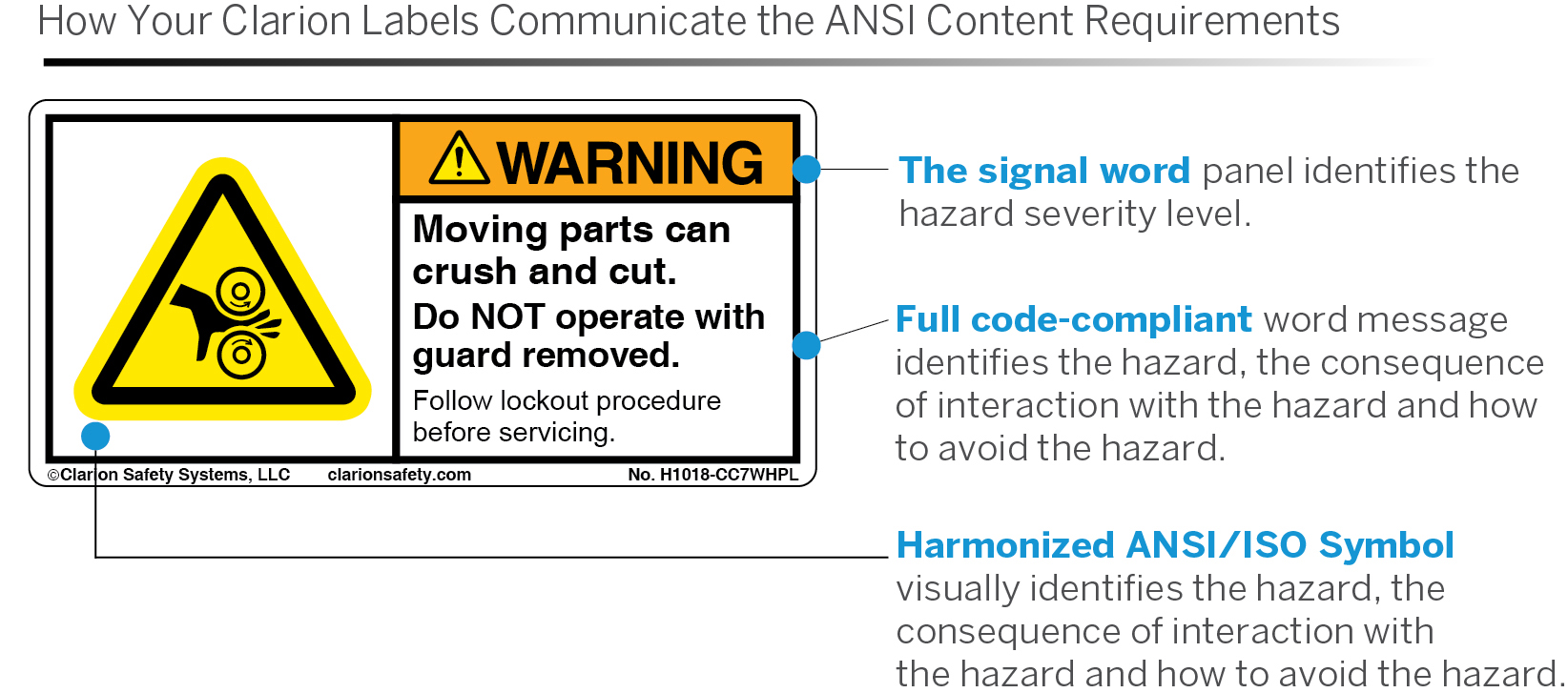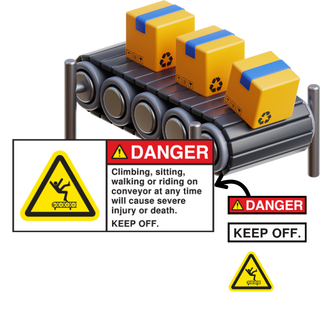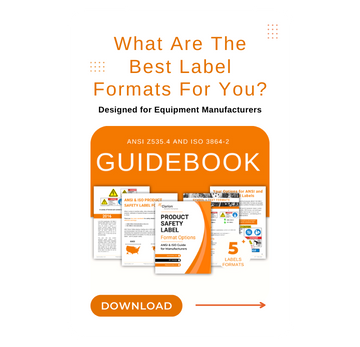Format and Content Matter
The choice of the format and content of your product safety labels is incredibly important. Choosing the wrong safety label format or not conveying the right content may lead to accidents, personal injuries, deaths, property damage, and litigation. Defining the proper content of your product safety labels is a serious matter that deserves your utmost attention.
Choosing Options That Are Right for You
Clarion Safety's experience helping manufacturers develop warnings for their products in over 180 industries has given us a very good understanding of the issues and challenges involved in creating safety label content. First, you should know that there is no one right approach to this issue; there is no one level of content that will work for every manufacturer and every product. The severity of the potential hazards, the complexity of avoidance procedures, the assumed knowledge level of the intended audience, and the markets where your products are sold all must be considered when developing the content for your labels. Our Customer Service Department staff can present you with options to choose from to determine what’s right for your company, your product, and your markets.
Get Started with your Free Label Consult Now.
Learn tangible ways to optimize your labels with a personalized assessment from the Clarion Safety team.
Get Started Today!
The Beginning of Content Determination: Risk Assessment
Defining the “right” level of content is something that begins with risk assessment. When your product development team performs a risk assessment on your product, potential hazards associated with its entire life cycle are defined. Lessening those hazards is what risk assessment and good product design are all about. Sometimes there are hazards that cannot be eliminated or guarded; that’s where product safety labels come into play as a means to communicate and lessen risk.
The Clarion Safety Product Safety Label Development Process
Once the decision is made to use on-product safety labels to inform people of residual risks associated with your product, Clarion Safety's experienced Customer Service Department staff is your resource to help choose formats, symbols, and text to match the content you have decided needs to be communicated. This is a collaborative process: you know your product and the potential hazards that need to be warned about; Clarion Safety knows the standards related to product safety labels and how to use these standards as a means to communicate safety. Because the choices involved may be critical to life safety, well-informed decisions must be made. Your expertise in your product will combine with our expertise in the standards to get this job done well.
Using the ANSI Z535.4 Standard to Define Content
There’s no question that the ANSI Z535.4 Standard for Product Safety Signs and Labels has revolutionized the field of on-product warnings. Before it was first published in 1991, product manufacturers were left on their own to invent label designs; very little standards-based guidance existed. Often manufacturers used the old, ANSI Z35-1971 OSHA-style safety sign formats shown below. Labels made with these formats typically had a large type, short generic messages, and lacked symbols. As a product manufacturer, you should know that in 2002 these old safety sign formats were completely removed from the ANSI Z535 standards for both facility safety signs and product safety labels. This was done for several good reasons, one of which was because they do not accommodate the type of content now expected for many safety signs and for practically all product safety labels. Note that for this same reason, OSHA decided in the fall of 2013 to include references to the newer ANSI Z535 safety standards in their regulations. Clarion Safety played a leadership role in this OSHA regulation change.

Examples of Old Safety Sign Formats Removed from the ANSI Z535 Standard in 2002
When it comes to product safety label content, the ANSI Z535.4 standard says a hazard alerting product safety label should* convey the following four content elements:
- The nature of the hazard (i.e. the type of hazard; for example, electric shock, cut, burn, etc.).
- The consequence of interaction with the hazard.
- How to avoid the hazard.
- The seriousness level of the hazard.
*ANSI Z535.4 highly recommends conveying all of this content information, but does not require it. With that said, the standard makes it clear that a manufacturer should be very cautious when deciding to eliminate any of these elements of content.
The illustration below shows how a typical Clarion Safety ANSI Z535.4 safety label does the job of conveying these four content elements.

When you choose to use the ANSI Z535.4 format for your on-product hazard alerting safety labels, our advice is usually to try your best to include all four content elements defined by the standard. The content defined by the ANSI Z535.4 standard is often cited in the literature on warnings and by U.S. courts. Over the years, since the ANSI Z535.4 standard was first published in 1991, this content has essentially become the prevailing U.S. legal definition for what constitutes an "adequate" warning.
As shown in the illustration above, and according to these ANSI standards, the first three items of content (describing the nature of the hazard, the consequence of interaction, and how to avoid the hazard) are conveyed by the word message and/or one or more symbols. The signal word panel communicates the last item of content – hazard seriousness.
An On-Going Process
The job of defining the proper content of your product's safety labels is one that is never finished. You must periodically re-evaluate your labels in light of changes to the standards, as new symbols become codified and as new safety and accident information relevant to your product comes to light. Choosing Clarion Safety as your safety label manufacturer benefits your company as we are always fully informed about how the safety signage standards are changing and which safety symbols are currently in the process of being registered by ISO.
As of 2022, the ANSI Z535 standards are getting ready for publication with the newest updates and information. The standards have yet to be published, although we have gathered from our Clarion Safety committee members that ANSI Z535.4 will be experiencing updates to include further clarifications on its usage with the other ANSI standards, along with new text, definitions, and minor modifications to its wording.

